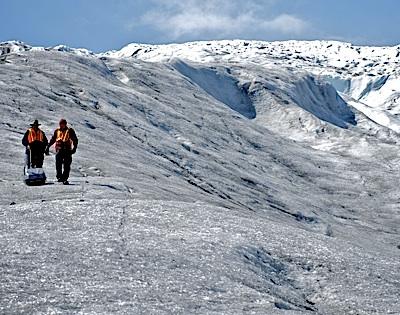Research at Kenai Fjords National Park this summer should provide a better understanding of how glaciers melt, move, and drain away their meltwater.
The work, being performed by a team from the University of Iowa, is focused on the lower sections of Exit Glacier. By using ground-penetrating radar, the researchers can map tunnels being carved between the glacier and the bedrock by meltwater.
“We thought it would be useful to look at a smaller glacier and get more detail of the tunnels,” said Frank Weirich, proffessor of Geoscience and Civil Engineering at the university.
At the end of the summer's work, the glacier's terminus and its tunnel system will be re-mapped to observe how the tunnel system has changed as the glacier moves and as water flows through, according to a Park Service release.
“The tunnels in the glacier are kind of like a plumbing system,” Professor Weirich said. “They’re always changing. Over the summer the plumbing system develops. The growth and evolution of those tunnels on a seasonal scale can be very useful in getting better models over weeks of glacial melting and tunnel development.”
The professor, who is being aided by gradaute student Susan Kilgore and senior Phil Kerr, are using the radar system in a grid pattern, moving back and forth across the toe of Exit Glacier. The collected data will be used to create a three-dimensional map depicting the bedrock beneath the glacier and the tunnels that form in the ice. Throughout the summer Ms. Kilgore will continue the study by using instrumentation to measure the amount of water flowing from the glacier each day.
“I’ve always been interested in glaciers and trying to learn about a part of glaciers not well known in the science community,” she said.
In the past few years researchers have conducted similar studies on the melting of the Greenland Ice Sheet, the Park Service noted, adding that ground-penetrating radar has become a more common method of collecting data due to its ability to closely detect the tunnels through which water moves.
The data collected at Exit Glacier will help contribute to the specific understanding of how Exit Glacier is changing, and to the more general understanding of glaciers around the world.




Add comment